India is a country like no other. You cannot describe the smell, the noise, and the colors of this country. This is something you have to experience yourself. It is a far cry from any other Asian country. India makes an impact on you. It can mean a lifetime of love or discomfort. Whichever it is for you, it will come with a “culture shock”. A visit to India will affect the way you think and your attitude in daily life. This country teaches you a lesson. Here you find 30 interesting facts and stories about India.
1. India is the birthplace of 4 religions: Hinduism, Buddhism, Jainism, and Sikhism
Small Hindu temples and shrines are scattered around the country, along the highway, and in the smallest villages. In the holiest city of India alone, in Varanasi, at the river Ganga, there are 3000 temples. Religious festivals and visiting temples make up most of the free time for Indians. The majority of Indians are Hindus, but with 12-13% of the population being Muslims, Islam is the second biggest religion in India. There are 2 million Hindu temples and 300 000 mosques in India.
Pin it for later!
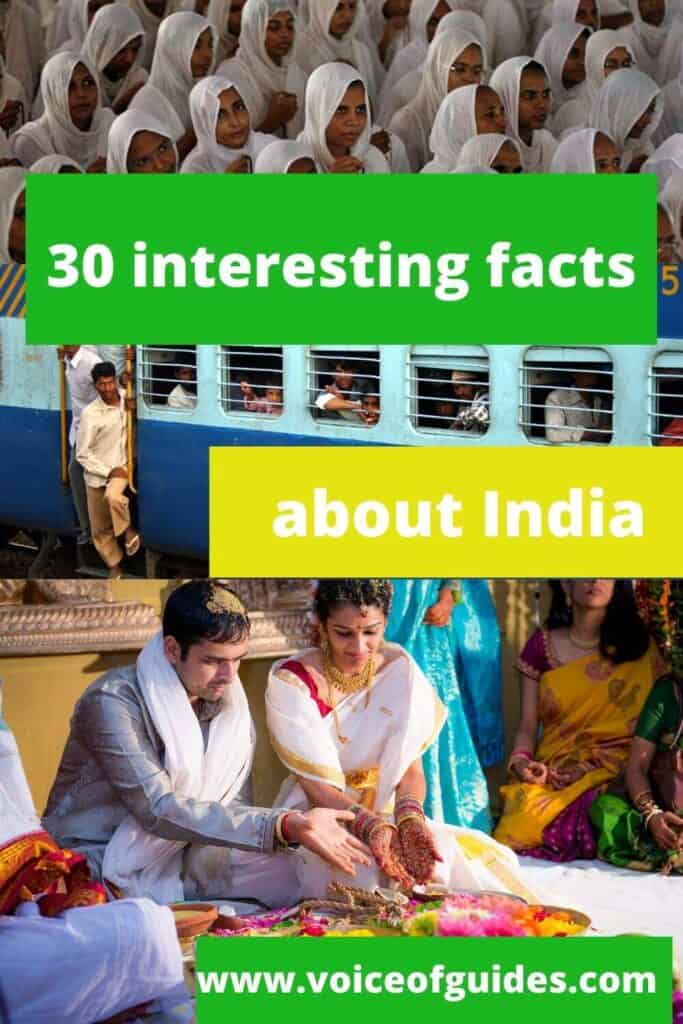
Though the Sikhs make up less than 2% of the total Indian population, they are the majority among the people in Punjab state. Despite their small number, they are usually in high positions, are successful businessmen, and well-known for organizing regular donations to the needy.
Jains make up only 0.36% of the population. Jainism is an extremely ascetic religion that puts the protection of all living creatures in its focus.
Read more about the most ascetic religion in the world, Jainism
The culture guide to the Sikh religion and what it means to be a Sikh
2. The Prime Minister of India, Narendra Modi launched the biggest toilet program in the world
In 2014, the Indian Prime Minister Narendra Modi launched the “Clean India” (“Swachh Bharat”) sanitation program to make the country cleaner and to improve general hygiene with a focus on building toilets all over the country. Before that, only 4 out of 10 households in the countryside had toilets. Of course, it was not enough to build toilets. They had to change the general mindset and behavior too. But they declared the program a big success. According to the official statistics, more than 60.000 toilets were built per day. As part of the campaign, wherever you go in India, “Clean India Green India” drawings and slogans decorate the walls. Cities were eager to compete for the “Open Defecation Free (ODF)” title.
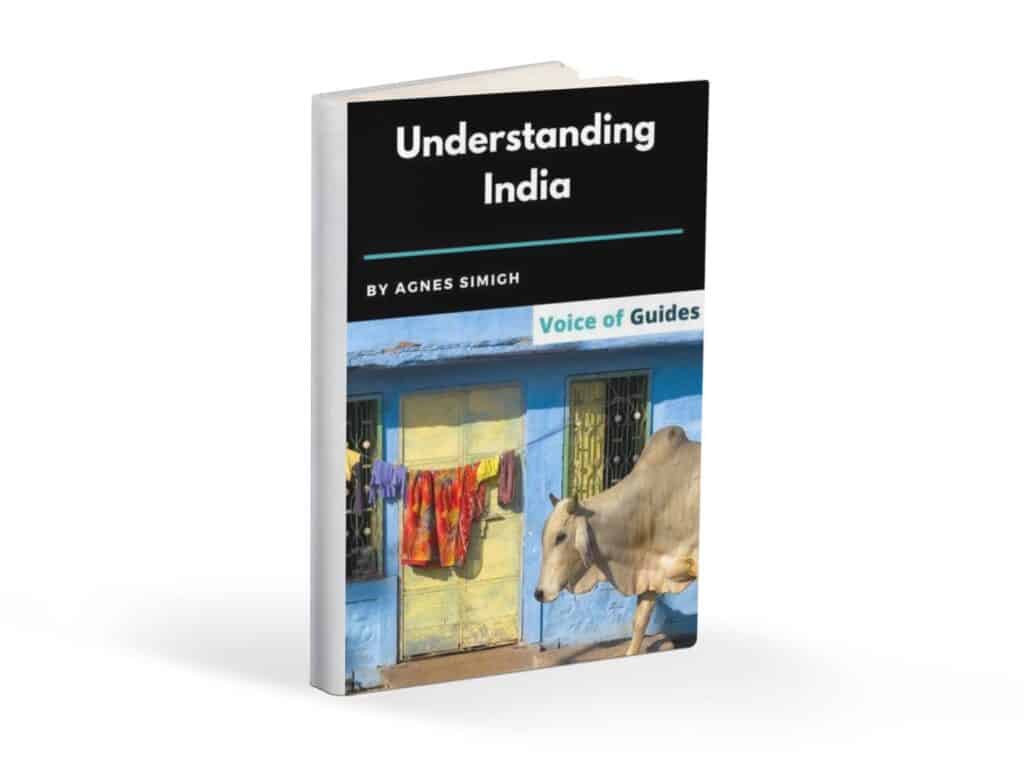
3. Indian doctors are not allowed to tell the future parents if they will have a girl or a boy
In India, it is more favorable to have a son than a daughter. The reason behind this is simple. To have a daughter is a big financial burden since the families of the bride have traditionally been expected to provide the dowry for the groom’s family. Earlier, if the family failed to provide the promised dowry, the groom took revenge by an acid attack or any other way that destroyed the girl’s life for a lifetime. Although the Indian laws prohibit to demand dowry now, it still happens, just arranged more discretely.
4. In 90% of the cases, young Indians still prefer arranged marriages
It may sound surprising that most young Indians, even those educated abroad, prefer that their parents select their spouse. They believe that their parents know better who would be the best choice for them. The couple meets only a few times before they give their final consent to the marriage. Or they can also express their dislike towards the chosen candidate, and then the search for the ideal candidate continues. So Indian marriages are more based on friendship and common respect than love. If we consider that India has the lowest divorce rate (only 1% of all marriages end up with divorce), it seems to be working. Though, a low divorce rate does not actually reflect the number of failed marriages.
Read the culture guide about how arranged marriages work in India
5. Hindus consider the cow a sacred animal. They would by no means eat beef
Holy cows have all the rights in India. They wander freely in the streets, pick some vegetables from the market sellers, and lie down in the courtyard of any home. The cow is a sacred animal for Hindus. It is the symbol of fertility and the companion of Lord Shiva, according to the Hindu mythology. Hindus do not eat beef and understandably, there is no beef burger in the McDonald’s either.
But Hindus actually make use of these animals in other ways. They drink cow milk and use the dried cow feces while cooking to replace the more expensive wood. Dried cow patty is actually a precious thing, and you can easily see them piled up along the roads.
When drivers put on the brake abruptly, you can almost be sure that it is because a cow was trying to cross the road. It is a disaster to hit the holy animal or damage them in any way.
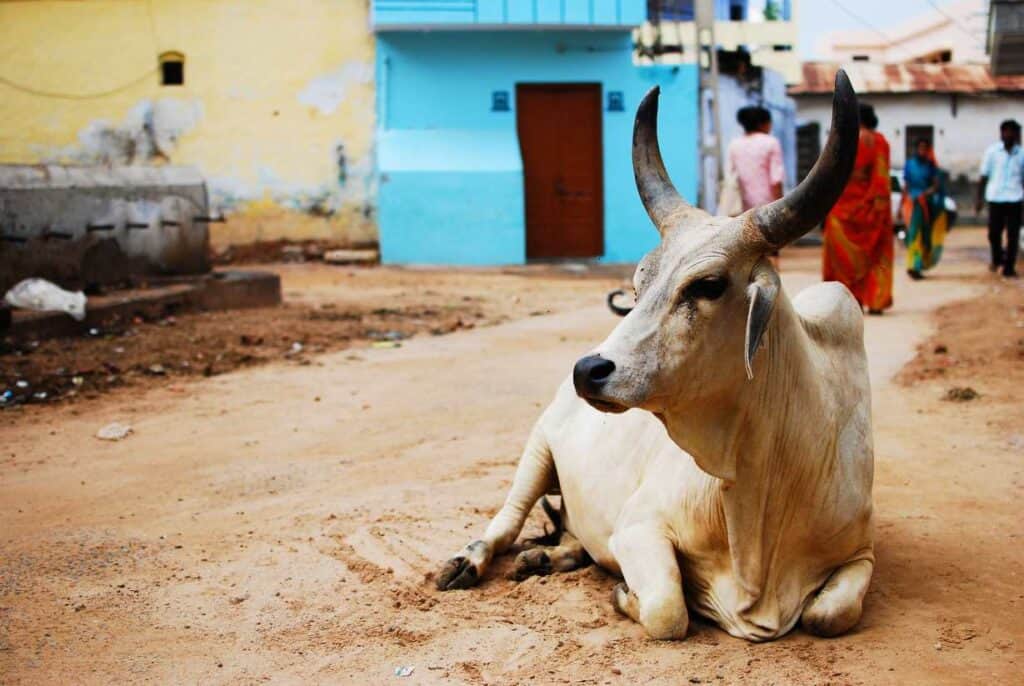
6. The most famous Indian painter of the 20th century is a 26-year-old girl, Amrita Sher-Gil
Amrita and Frida Kahlo were the pioneers of women’s freedom. Amrita Sher-Ghil died tragically at the age of 28 in 1941, but her paintings are still among the most expensive ones. Her talent was comparable with that of Pablo Picasso. Amrita was an extraordinary painter but had an extremely scandalous life with countless sexual relations involving both men and women. She literally lured everybody in her bed, which probably caused her tragic death. She married her cousin Egon, but they agreed not to have any children from an incestuous relation. Egon had a great understanding of Amrita and tolerated all her lovers. He, as a doctor, executed several abortions for Amrita. The last one probably caused her death.
Some of her most famous paintings are: Three Girls, Mother India, Two Elephants
Take a visit in the National Gallery of Art in New-Delhi and visit the Amrita Sher-Gil exposition.
7. Phoolan Devi, once a bandit queen, became a member of the Parliament
The incredible story of the bandit queen is another interesting fact about India. Phoolan Devi was married at the age of solely eleven when she had little idea what it meant. She was just needed as a maid for the house, nothing else. She was beaten and molested by her husband and many others for being just a “trashy Mallah” (belongs to the lowest of the four Indian castes), and as such, she was destined to be a whore. Phoolan became a bandit, learned how to handle a weapon, and made a list of all those who have dishonored her (like Arya in Game of Thrones).
The desire for revenge consumed her totally, and she started to kill her enemies with her own hands. In the end, she had no choice but to surrender. This was not just her story. It was a mirror to the lower Indian society at that time.
8. Bollywood makes India the biggest film producer in the world
Bollywood, the Mumbai-centered film industry, produces the biggest number of movies with an average of 1000 movies a year. This is far more than in Hollywood. The only time when no films came out was during the Cricket World Cup, the other obsession of Indians. Bollywood movies have the reputation of being childish, not touching real social or political issues, and always packed with fun dancing and singing video clips. This is only partly true.
In the new era of Indian movies, there are action movies, dramas and thrillers that contain less or no such elements at all. Movies cover serious social and political problems, like the caste system, Hindu-Muslim conflicts, and arranged marriages. In the end, the professional dancing and singing elements add to the experience. Indian movies are produced in Hindi, but many are subtitled in English. So if you are in India or at home, it is a great experience to watch a Bollywood movie.
Bollywood actors are like half Gods in India
There is no other country where stars enjoy popularity as big as in India. The most famous Bollywood actors and actresses live a luxurious life in one of the high-security villas at Juhu Beach or on the Malabar Hill in Mumbai. They sign well-paying advertisement contracts and host TV shows. You come across the Bollywood stars and crickets players on billboards placed all around the country. Shah Rukh Khan, Amir Khan, Salman Khan, Hrithik Roshan, Karina Kapoor, Deepika Padukone, or Priyanka Chopra are household names in India. Their private lives are also well-displayed thanks to the gossip columnists.
The shootings take place in the Film City in Mumbai. If you are lucky, you may get selected as an extra from the street.
Take an organized tour to look behind the scenes of Bollywood.
9. Auroville, the experimental town based on human and eco principles
Located in South India, in Tamil Nadu state, some 12 kilometers from Pondhicherry, Auroville was founded with the mission to unite men and women from every nationality and build up an eco-friendly, community-based lifestyle. Auroville wants to be the sample town of peace and harmony for the future.
Up to now, the idealistic town has only a couple of thousand inhabitants. But plans to grow fast to become a city of 50,000 with inhabitants from all over the world. It was founded in 1968 by Mirra Alfassa (known as “the Mother”).
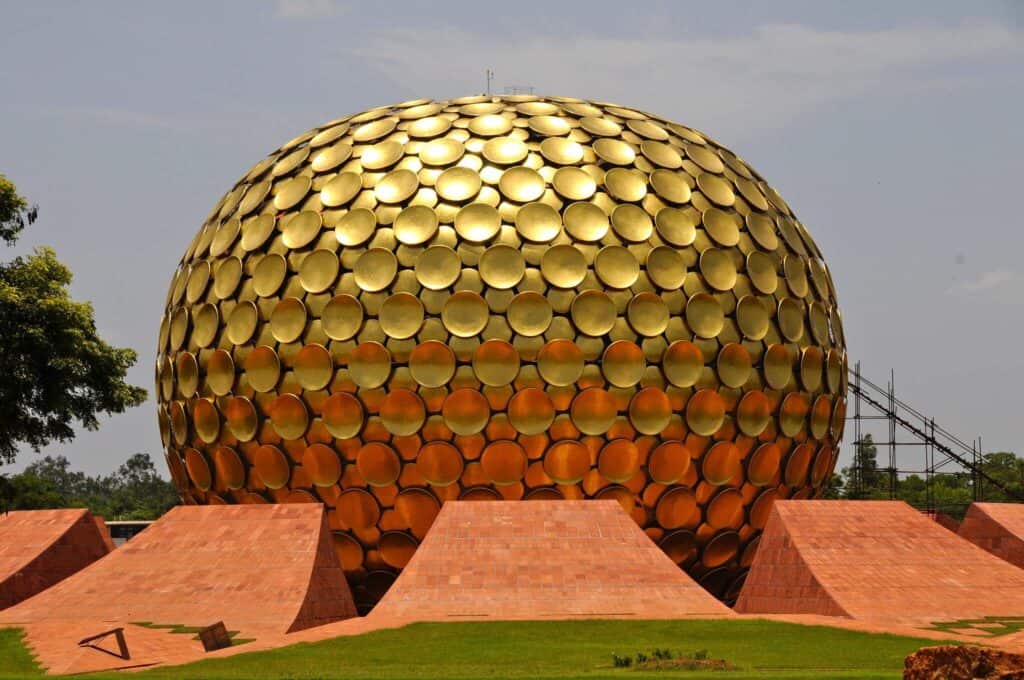
Auroville offers workshops for researchers and all those interested in its structure. Residents of Auroville do not get banknotes and coins. Instead, they are requested to open a temporary bank account and use an Aurocard (debit card). They have to make a monthly contribution to the budget of the town.
The economy of Auroville is mainly based on small commercial activities (producing incent sticks, handmade papers), donations, and welcoming tourists and guests.
More about Auroville: https://auroville.org/
10. Shani Shingnapur: a village so safe that the inhabitants do not use doors and locks
How can a village be so safe that people do not even install doors and locks on their homes? Shani Shingnapur, a village in Maharashtra claims that they do not need to worry about security issues because they enjoy the protection of Lord Shani.
Lord Shani appeared among the villagers in the form of a miraculous black slab. This sacred piece of stone is the guardian of the village. The person who dares to steal will be punished with bad luck for 7 and a half years, according to the belief.
Even the police station has no locks. The branch of the United Commercial Bank (UCB) was opened with a glass door only without any further security measures.
The village gained a reputation as the safest place on earth and attracts 40,000 devotees each day. Precisely, all that was true until 2010, when there was a theft case. The villagers argued that it happened outside the village since they do not want to lose this lucrative reputation.
But even some inhabitants started to push for permission to install doors despite the hundreds of years old tradition.
Women have been banned to enter the Shani temple because of the “harmful vibrations emanating from Lord Shani”. In 2016, thousands of women activists tried to get into the sanctum. Shortly afterwards the High Court of Mumbai ruled in their favor. The 6 decades-long tradition is so strong that local women still refuse to enter the temple. The protest at the Shani shrine made headlines and incited several other temples that have similar restrictions.
11. India produced the world’s cheapest car, the Tata Nano
The big conglomerate, the Tata concern (highly reputed in steel, auto and hotel industry) decided in 2008 to assemble the “People’s Car”. The cheapest car possible so that more families could afford to use a car instead of motorbikes. The ”1 lakh car” (100 000 Rps ~ 1400$), the Tata Nano, seemed to change the lives of Indians. By reducing the production costs, the small car became affordable. But Tata Nano did not become a big success. Technical defaults were common, and they could not keep the low production costs in the long term. The price increased, and after 10 years of production, they announced to terminate its manufacture.
12. From Delhi to London, the longest bus route in the world to be launched in 2021
The longest bus tour from Delhi to London is planned to start in May 2021 (provided the health situation permits it). This one-way journey would work like an organized tour, which means that the passengers buy a package that includes bus transport, admin fees, accommodation, meals and tour guides at the most famous sights along the road. The super-adventurous cross-continent trip would cover 20,000 kilometers through 18 countries in 70 days! Definitely a life-changing experience!
13. There are 22 official languages in India
India is the only country with 22 official languages. Hindi, Marathi, Bengali, Punjabi, Kashmiri, Assam, Gujarati, Sanskrit, and so on. Almost every Indian state has an own language. To understand each other, every Indian must be bilingual. Apart from the local language, they speak Hindi, the language everybody can understand. This the language of Bollywood movies as well.
14. The Kumbh Mela festival is the biggest celebration in the world with 70 million pilgrims
Millions of Hindus make the pilgrimage to the Kumbh Mela festival, held at four different venues every three years. By attending the festival Hindus believe they can get rid of the vicious cycle of births and rebirths, and achieve the eternal salvation where there is no more pain and suffering. It is the world’s largest gathering of human beings and has been a UNESCO World Cultural Heritage since 2017. Tens of millions of Hindus, religious ascetics and sadhus gather here to partake of the divine energy.
15. India has the tallest statue in the world
Inaugurated in 2018, the 182m high statue of Sardar Vallabhbhai Patel, India’s first interior minister and deputy minister is twice as tall as New York’s Statue of Liberty. Some say Patel would have deserved to become Prime Minister as well. The monument is a tribute to the leader of independence. The statue surpasses the 128 meters-high Spring Temple Buddha in China, previously the tallest statue. Visitors can go up to the gallery at 153m, at the chest of the political icon.
Surprisingly, they did not choose an internationally better-known character of the independence movement. Also strange that the monument stands in the Western state, Gujarat. It shows that the new attraction targets primarily domestic tourists. The reason for the choice of the scene is simple. Narendra Modi, the Prime Minister of India, commissioned the statue in 2010, as chief minister of Gujarat.
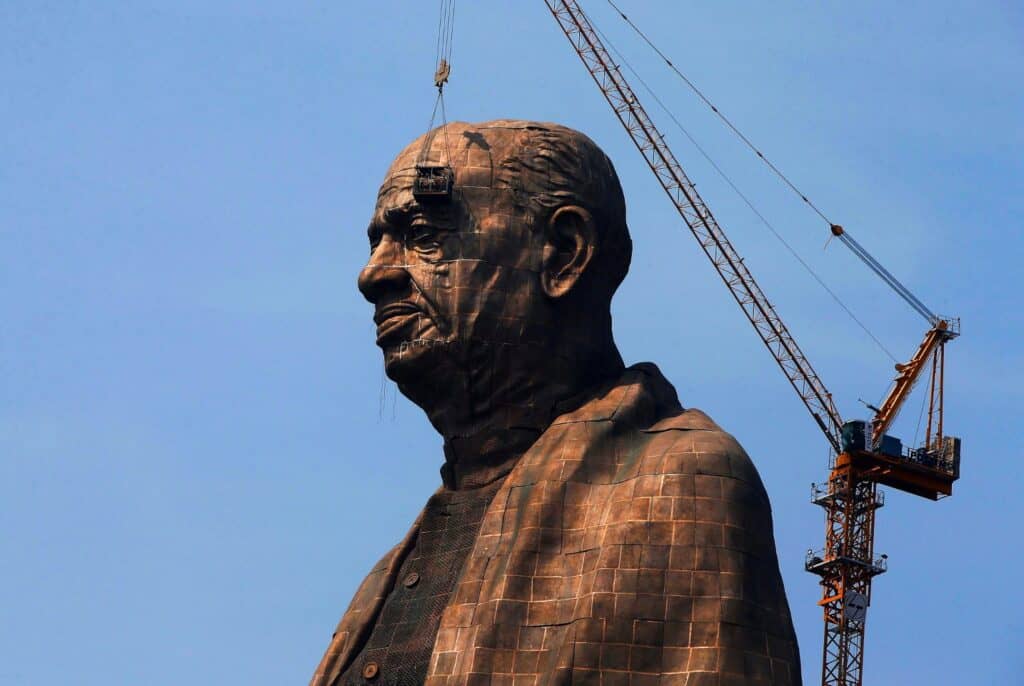
16. The world’s third-largest mountain, the Kangchenjunga (8586m) is in India
The Himalaya mountain range stretches over to India in the northeastern part of the country. It consists of several mountains with 6000 and 7000 meters-high peaks. The Kangchenjunga (8686m) is a popular trekking destination at the border between the Sikkim state in India and Nepal. It literally means the „Five Treasures of Snow”, and locals have a good explanation for what these 5 treasures mean. Kangchenjunga is one of the most dangerous and thus one of the least climbed peaks. Locals say that demons and spirits reside there. Whoever comes near the peak puts his life at risk. Some climbers insisted that they have seen ghosts and demons on the top. But these are most probably hallucinations caused by the extreme lack of oxygen.
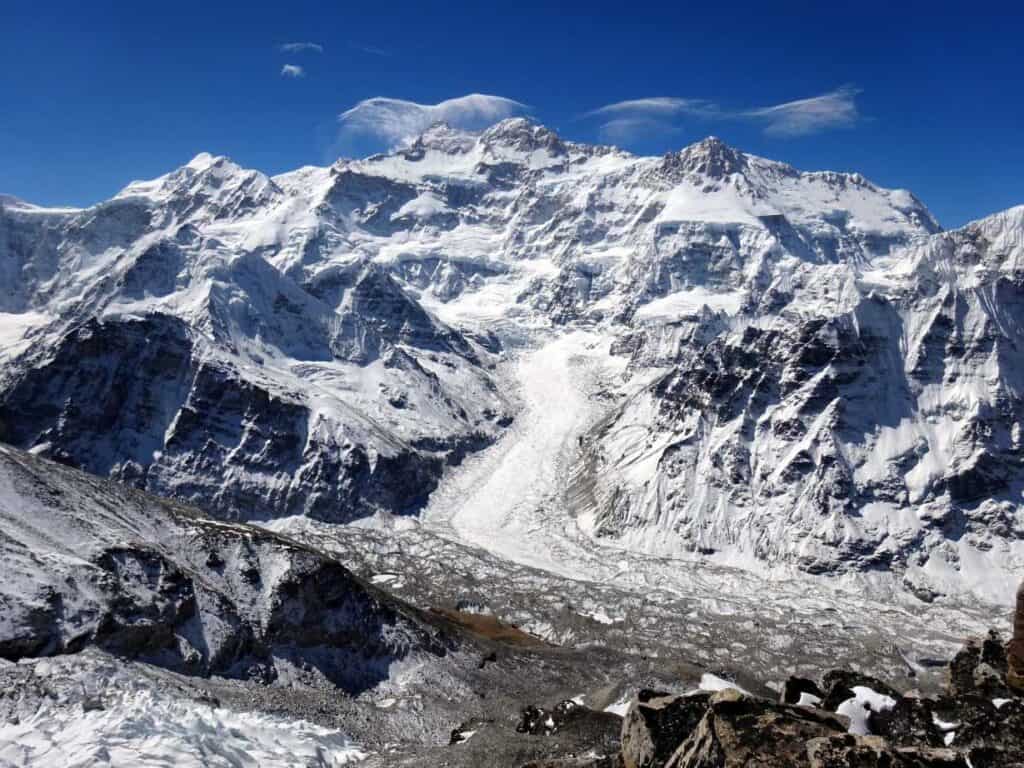
17. Indian couples celebrated some of the most expensive weddings in the world
Indians do not cut corners when it comes to weddings, regardless of their financial situation. Even the needy families spare all their lives for a decent wedding for their daughter. Upper society Indians organize lavish parties with thousands of guests.
It is no surprise that Vanisha Mittal, the daughter of the Indian millionaire Lakshmi Mittal celebrated one of the most expensive weddings in the world. They rented the Versailles palace near Paris for the 6-day event occasion in 2004. This was the only time that the palace was a scene to a private event.
The entertainment with famous stars made a bill of $50-60 million.
The wedding of the richest Indian tycoon, Mukesh Ambani’s daughter made headlines in 2018 with its extravagance. More than 200 charter planes carried the guests to the pre-wedding reception on an island in Udaipur. Among other Indian celebrities, Beyonce was invited to give an exclusive concert for the couple. The wedding reception was held in the 27-storey Ambani residence in Mumbai. Hillary Clinton and John Kerry were among the prominent guests as well. Some news portals talked about costs of $100 million. This means that the wedding would compete with that of Prince Diana and Prince Charles, which sounds a little bit unrealistic. But it was definitely one of the fanciest weddings ever.
18. Ayurveda is the earliest school of medicine known to humanity
The father of Medicine, Charaka consolidated Ayurveda 2500 years ago. So Ayurveda is the earliest school of medicine. It focuses on natural methods that serve the health of the body and soul. The well-being of the mind can transform a person’s whole being. In India and the surrounding countries, Ayurveda is the most relevant form of medicine. In the 1970s, 1980s, Western countries also started to discover and apply it.
19. Varanasi is the oldest continuously inhabited city in the world
Varanasi or Banaras is the holiest city of India, located at the river Ganga. Its houses are shabby, and the streets are like labyrinths. According to legend, the Hindu deity Lord Shiva founded it 5,000 years ago, though modern scholars believe it to be around 3,000 years old.
“Older than history, older than tradition, older even than legend and looks twice as old as all of them put together”
Mark Twain about Varanasi
Maybe not the most charming place, and it may feel depressive for the first-time visitor. But you have to visit Varanasi to understand India. Hindus believe if they die in this city, they attain the long-wished eternal salvation. Piles of woods packed against the walls of narrow streets are ready for cremation. The pyres at the river bank keep on burning for 2000 years. “The untouchables” are changing the dead body one after the other, while small children jump joyfully in the holy river some hundred meters away.
20. The Dalai Lama lives in exile in Dharamsala
The current Dalai Lama (Tenzin Gyatso), not acknowledged as the head of Tibetan Buddhism by the Chinese Authorities, had to go to exile in 1959. Jawaharlal Nehru, the prime minister of neighboring India, offered him shelter in McLeodGanj, Upper-Dharamsala. After the uprising of 1959, many other Tibetans followed him. Dharamsala, a mountain city in Himachal Pradesh, became the seat of the “Government-in-exile”. The Tibetan refugees built monasteries, temples and schools. The collection of the library opened by the Dalai Lama is one of the most important for Tibetology.
The presence of the Dalai Lama and the Tibetan community turned Dharamsala into a touristic place with plenty of hotels and guesthouses.
21. Maharajas converted their palaces into heritage hotels, thus any visitor can enjoy the royal treat
Indira Gandhi, prime minister of India, abolished the title and privileges of maharajas in 1971. Although officially not addressed as maharaja anymore, most royal families are still wealthy and respected members of their local society. After the country’s independence in 1947, they struggled to cover the maintenance costs of the royal residences. They decided to convert them into luxurious heritage hotels. Thus, any visitor has now the chance to literally move into the home of a maharaja and enjoy this unique experience. The former royal palaces have been embraced by the HRH (Historic Resort Hotels) hotel brand.
22. The Maharaja of the Alwar dynasty damaged the image of the Rolls Royce brand
There is a well-known anecdote about the Maharaja of the Alwar dynasty, who traveled to London to extend his collection with Rolls Royce cars. Since he went to the car salon in casual attire, the salesman did not consider him as a customer worth of attention. Next time the maharaja announced his visit to the showroom in advance and bought 6 cars in cash. When the cars arrived in India, he ordered that these cars are to be used to deliver garbage as revenge for the unpleasant welcome at the Rolls Royce showroom.
23. India can also be a beach holiday destination
India may not be your first choice to go on a beach holiday, but it also has beautiful beaches and nice resorts. The two main destinations are Goa on the West Coast and the Andaman Islands which are 1370 kilometers off the east coast of India in the Bay of Bengal.
Goa is the main choice for Indians and foreigners for relaxing in one of the hotels along the 100 kilometers long beach. Goa welcomes backpackers as well as luxury travelers. The 5-star properties have their own private beaches. It has trendy bars, clubs and casinos, and the best nightlife in India. The forts and churches recall that Goa was once a Portuguese colony. It became part of India only in 1961.
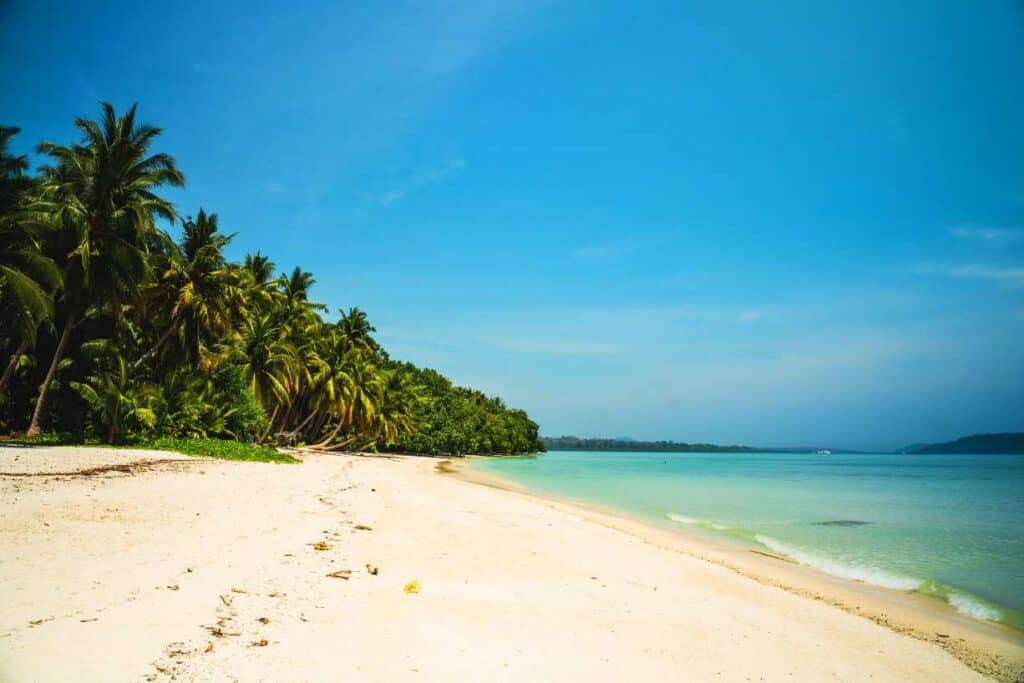
If you long for a secluded, still relatively unspoiled exotic holiday, go to the Andaman Islands. The Andaman & Nicobar Archipelago is actually closer to Indonesia and Burma than to mainland India. Less than 40 out of the 572 islands are inhabited. The pearly white-sand beaches and palm-lined shores make Havelock and Neil the most popular islands. Andaman is a great place for scuba diving and snorkeling and to enjoy the peace far from big cities. There are direct flights to Andaman from Kolkata, Bangaluru, and Chennai cities with 2.5 hours of travel time.
24. The rat temple in Bikaner is home to thousands of holy rats
The Karni Mata temple in Deshnok (30 kilometers from Bikaner) is the home of almost 25.000 rats. According to the local legend, they are considered the reincarnations of human beings. Many Hindus undertake a long journey to revere the goddess, Karni Mata, and the temple rats. It is an honor to eat the food that the rats nibbled before, to share the plate with them, to touch and pamper them, or make them eat out of your hand. According to tradition, it brings luck if you manage to spot one of the only 4-5 white rats among the 20,000 grey ones. They say these white rats are Karni Mata herself and her four sons.
Read more about the Karni Mata temple in Deshnok
25. Mahatma Gandhi figures on every Indian banknote
The national currency of India is Rupee. There are banknotes of 5, 10, 20, 50, 100, 200, 500, and 2000 Rupees. Mahatma Gandhi, the “Father of the Nation” figures on all of them. Gandhi is inarguably the first person anybody links to India. The independence fighter chose the non-violent resistance as a way to protest against the British oppression. He showed an example with his modest lifestyle and wore the self-made white “dhoti” even during official visits. He started to fast for the peaceful cohabitation of Muslims and Hindus inside India.
Gandhi was assassinated on 31 January 1948.
Learn more about the Father of Nation, Mahatma Gandhi
26. Hindus do not bury but cremate the deceased
You will only find Muslim cemeteries in India. Hindus with few exemptions never bury the deceased. They always cremate them. It is because they believe in reincarnation, and the soul is reborn faster in this way. Besides, it is much more space-saving, cheaper and symbolizes purification. Cremation is often done the same day but no later than 24 hours. The belief in reincarnation easies the pain of loss. Traditionally only men can be present, and they must have a shower after returning home.
The culture guide to Hindu death rituals
27. There are two Indian cities on the list of the 10 most populous cities in the world
With 1.38 billion inhabitants, India currently has the second biggest population but approaches China (1,43 billion) year by year. If the tendency continues, India will come to the top position. Although 80% of the population lives in the countryside, two Indian cities are listed among the world’s 10 most populous cities.
Delhi with 29million is 2nd after Tokyo, and Mumbai takes 8th place with around 20 million inhabitants.
28. Cricket is, without doubt, the number one sport in India
Indians are born with a love for cricket. When the Indian team is playing, they are glued to the television. Small children play cricket at every possible spot and adore the cricket stars as Gods. The caste system of India highly limits who you can become by birth. But cricket knows no caste. Whatever background you have, with talent and hard work you can be one of the superstars.
The Indian cricket team is one of the best in the world and this is the man thing that connects this vast country.
29. Indians have the biggest quantity of gold per household
Everybody is wearing gold and other jewelry in India. You would not expect that in a country where a quarter of the population lives under the poverty line. From poor to rich almost everybody is wearing nose piercings, ankle chains, earrings, and necklaces. Jaipur, the city of gems and stones has 3000 jewelry shops.
The amount of jewelry an Indian bride wears during her wedding reflects how wealthy the family is.
29. Vegetarian paradise
The Hindu religion does not oblige the followers to be vegetarians, but the more religious Indians are refusing to eat meat. Especially in India you will discover that vegetarian food can be filling, delicious and is far from being a monotonous diet.
The Indian kitchen is one of the best in the world and is famous for its tasty, spicy dishes.
Malai Kofta (Veggie Balls in a Thick Sauce), Palak Paneer (Spinach and Cottage Cheese), Mutter Paneer (Peas and Cottage Cheese), Aaloo Paratha (Potato Paratha), and Chole (Chickpea Curry) are just a few of the plenty of delicious vegetarian meals in India.
Useful resources for your travel to India
Insurance: Safetywing insurance that covers COVID-related issues as well.
Train, bus and flight ticket: Book your train ticket at Indian Railways website, or 12Go which gives you the best option (train, bus, and flight) based on the city of departure or arrival.
For your flight ticket use Google Flights.
Accommodation: Booking.com and Hostelworld.com offer a wide choice of low and higher-budget hotels.
Local tours and tour packages: Viator and GetYourGuide offer transfers and several one or multi-day tours.

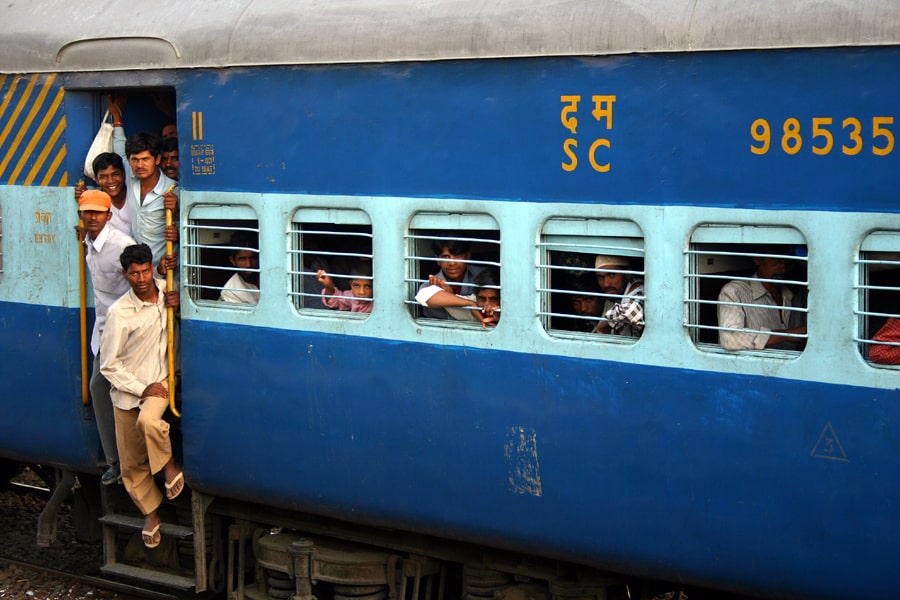

Pingback: From Delhi to London in hop-on-hop-off style | Voice of Guides
Pingback: Phoolan Devi: the story of the famous bandit queen | Voice of Guides
Pingback: Heritage Hotels in India: Live like a maharaja in a royal palace | Voice of Guides
Pingback: The Clean India Green India project: the largest toilet program in the world | Voice of Guides
Pingback: Cricket, without doubt, the most popular sport in India | Voice of Guides
Pingback: How the Indian maharaja destroyed the reputation of Rolls-Royce | Voice of Guides
Pingback: Karni Mata temple: It’s an honor to share your plate with a rat! | Voice of Guides
Pingback: The principles and teachings of Mahatma Gandhi | Voice of Guides
Pingback: The principles of Jainism, the most ascetic religion in the world | Voice of Guides
Pingback: Hindu death rituals - why do Indians cremate the dead? | Voice of Guides
Pingback: “Latika in Slumdog Millionaire”: a little girl’s way out of the slums of India onto the red carpet of Hollywood | Voice of Guides
Pingback: All you need to know about the Sikh religion | Voice of Guides
Pingback: The culture guide to arranged marriages in India | Voice of Guides
Pingback: How to celebrate the Holi festival in Mathura-Vrindavan | Voice of Guides